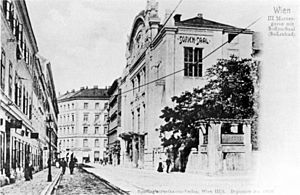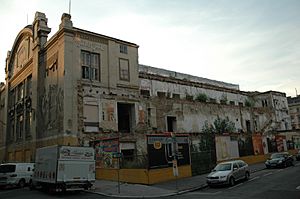Sofiensaal facts for kids
The Sofiensaal (also known as Sofiensäle) is a famous building in Vienna, Austria. It used to be a public bath and a popular place for concerts. It was built between 1845 and 1848 by two architects, Eduard van der Nüll and August Sicard von Sicardsburg.
In winter, people would come to the Sofiensaal to swim in its large pool. But when summer arrived, the pool was covered with wooden planks. This turned the space into a big hall perfect for concerts, dances, and other events. Many important things happened here over the years. For example, in March 1912, the famous writer Karl May gave his very last public speech at the Sofiensaal to about 2,000 people. In September 1913, it even showed some of the first movies that had sound! However, this stopped because it was hard to make sure the sound matched the picture perfectly, a problem called synchronicity.
Contents
A Place Through History
The Sofiensaal has seen many changes throughout its long history.
During World War II
In May 1938, a political group called the NSDAP started its Austrian section at the Sofiensaal. During World War II, the building was sadly used as a gathering point for people who were later sent away from their homes.
After the War
After the war, the Sofiensaal was carefully repaired and brought back to its original beauty by architect Carl Appel in 1948. In the 1950s, a record company called DECCA set up a very modern recording studio inside the building. This studio was one of the best in Europe at the time. It was used until the 1970s to record music from famous groups like the Vienna Philharmonic Orchestra.
Later Years and Rebirth
In the 1990s, the Sofiensaal became a popular place for clubbing and nightlife. However, in 2001, a big fire completely destroyed the building. But the story didn't end there! The Sofiensaal was rebuilt and reopened in 2013, continuing its long history as an important part of Vienna.
Images for kids






